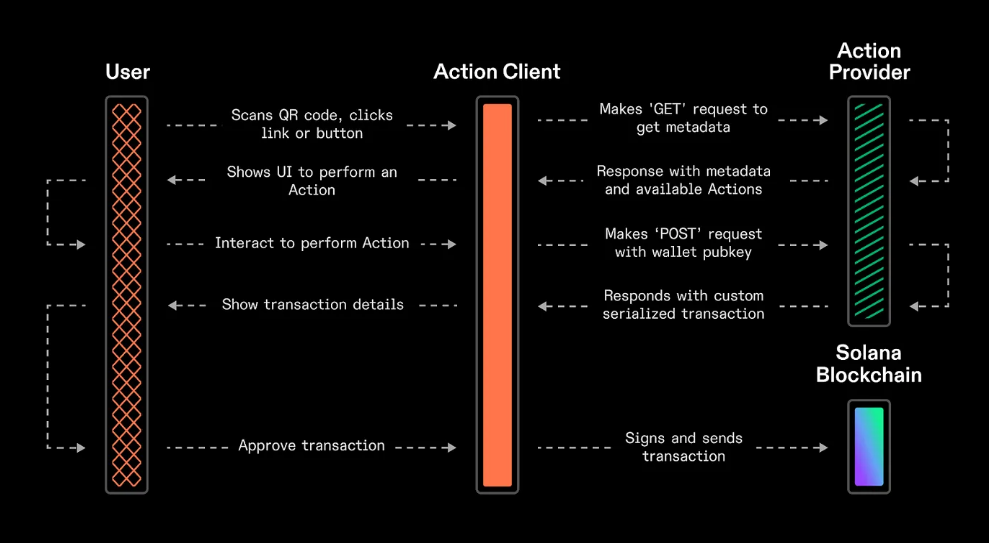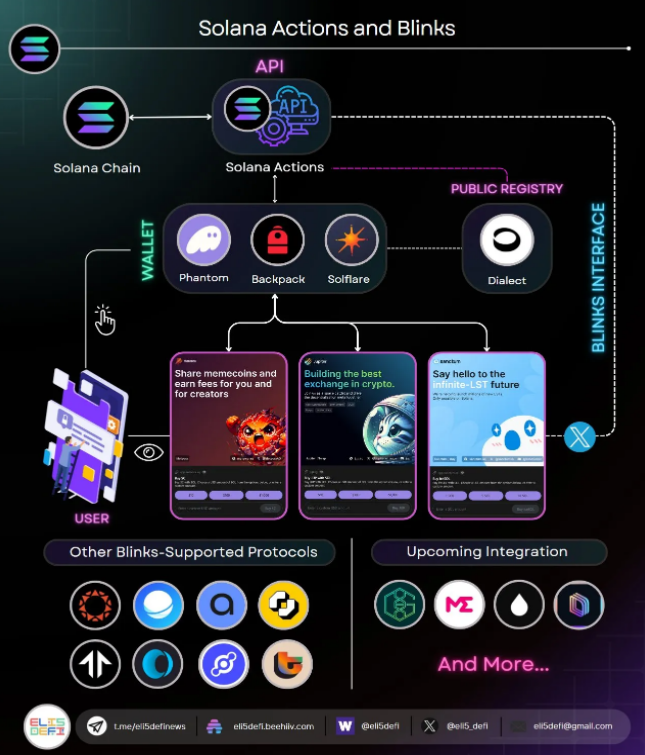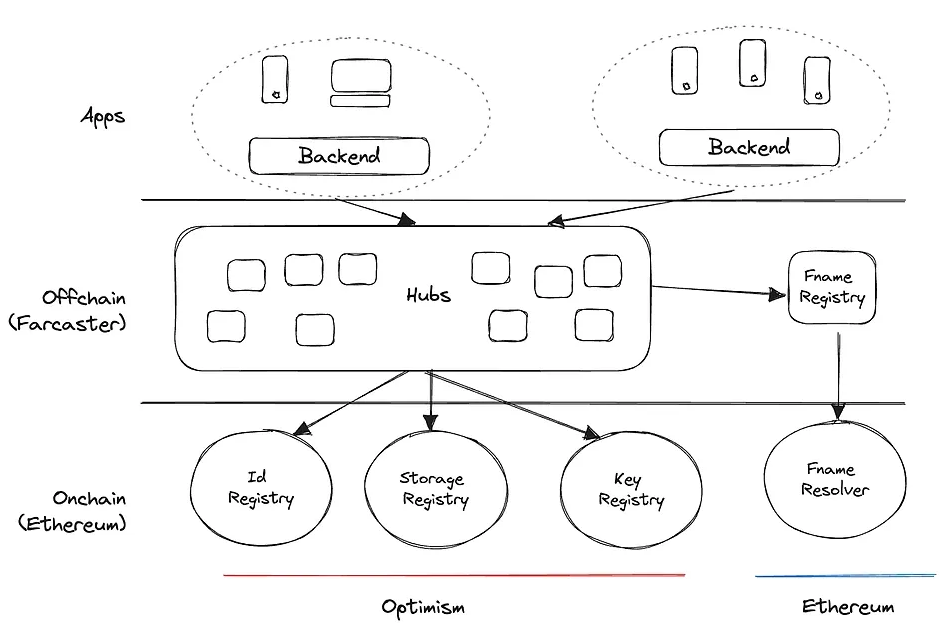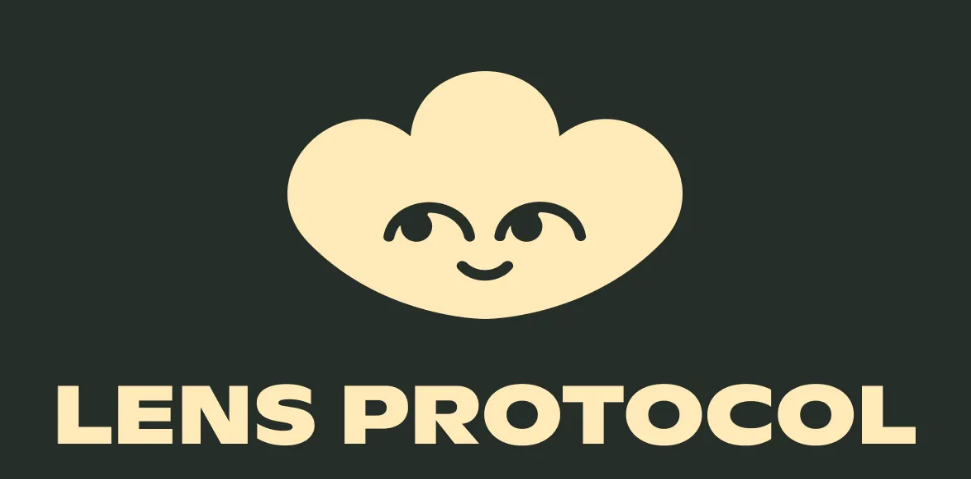Author: YB
Translation: Plain Language Blockchain
Recently, Solana and Dialect jointly launched a new Solana concept "Actions and Blinks", which implements one-click operation functions such as exchange, voting, donation, and minting through browser extensions. Actions simplify the execution of various operations and transactions, while Blinks ensure network consensus and consistency through time synchronization and sequential recording. The combination of the two enables Solana to provide a high-performance, low-latency blockchain experience. The development of Blinks requires support from Web2 applications, which brings issues of trust, compatibility, and collaboration between Web2 and Web3. Compared to Farcaster and Lens Protocol, Actions and Blinks rely more on Web2 applications to obtain traffic, while the latter relies more on on-chain security.
1. Working Principles of Actions and Blinks

1) Actions (Solana Actions)
According to the official definition: Solana Actions are standardized APIs for transactions on the Solana blockchain. These transactions can be previewed, signed, and sent in various environments, including QR codes, buttons + widgets, and websites on the Internet.
Actions can be simply understood as transactions awaiting signature. Furthermore, Actions are an abstract description of transaction processing mechanisms in the Solana network, covering various tasks such as transaction processing, contract execution, and data operations. Users can send transactions through Actions, including token transfers and purchasing digital assets. Developers use Actions to call and execute smart contracts, implementing complex on-chain logic.
Solana processes these tasks through "Transactions", each of which consists of a series of instructions executed between specific accounts. Through parallel processing and the Gulf Stream protocol, Solana forwards transactions to validators in advance, reducing confirmation delays. Through fine-grained locking mechanisms, Solana can simultaneously process a large number of non-conflicting transactions, greatly increasing system throughput. Solana uses Runtime to execute transaction and smart contract instructions, ensuring the correctness of transaction inputs, outputs, and states during execution.
After initial execution, transactions await block confirmation. Once a majority of validators agree on a block, the transaction is considered final. Solana can process thousands of transactions per second, with confirmation times as low as 400 milliseconds. Thanks to the Pipeline and Gulf Stream mechanisms, the network's throughput and performance are further improved.
Actions are not just tasks or operations; they can be transactions, contract executions, or data processing. These operations are similar to transactions or contract calls in other blockchains, but Solana's Actions have unique advantages:
Efficient processing: Solana has designed an efficient method to process Actions, enabling rapid execution in a large-scale network.
Low latency: Solana's high-performance architecture ensures that the processing latency of Actions is very low, supporting high-frequency transactions and applications.
Flexibility: Actions can perform various complex operations, including smart contract calls and data storage/retrieval (for more detailed information, please refer to the expansion link).
2) Blinks (Blockchain Links)
According to the official definition: Blinks can convert any Solana Action into a shareable link rich in metadata. Blinks enable clients supporting Actions (browser extension wallets, bots) to display more functions to users. On websites, Blinks can trigger transaction previews in wallets immediately without redirecting to decentralized applications; in Discord, bots can expand Blinks into a set of interactive buttons. This allows any web interface displaying URLs to initiate on-chain interactions.
In simple terms, Solana Blinks convert Solana Actions into shareable links (similar to HTTP). By enabling relevant features in supported wallets (such as Phantom, Backpack, and Solflare), websites and social media can become places for on-chain transactions, allowing any website with a URL to directly initiate Solana transactions.
In summary, although Solana Actions and Blinks are permissionless protocols/standards, they still require client applications and wallets to ultimately help users sign transactions, compared to intent narrative solvers.
The direct goal of Actions and Blinks is to "HTTP-link" Solana's on-chain operations and parse them into Web2 applications such as Twitter.

2. Application of Decentralized Social Protocols on Ethereum
1) Farcaster Protocol
Farcaster is a decentralized social graph protocol based on Ethereum and Optimism, enabling applications to interconnect through decentralized technologies such as blockchain, P2P networks, and distributed ledgers. This allows users to seamlessly migrate and share content across different platforms without relying on a single centralized entity. Its open graph protocol (automatically extracting and injecting interactive features into shared content from social network posts) enables shared content to be automatically extracted and transformed into interactive applications.
Decentralized network: Farcaster relies on a decentralized network, avoiding the single point of failure problem common in traditional social networks. It uses distributed ledger technology to ensure the security and transparency of data.
Public key encryption: Each Farcaster user has a pair of public and private keys. The public key is used to identify the user, while the private key is used to sign their operations. This approach ensures the privacy and security of user data.
Data portability: User data is stored in decentralized storage systems rather than on a single server. This allows users to have full control over their data and migrate between different applications.
Verifiable identity: Through public key encryption technology, Farcaster ensures that each user's identity is verifiable. Users can prove control of their accounts by signing operations.
Decentralized identifiers (DIDs): Farcaster uses decentralized identifiers (DIDs) to identify users and content. DIDs are based on public key encryption and have high security and immutability.
Data consistency: To ensure data consistency on the network, Farcaster uses a consensus mechanism similar to blockchain (with "posts" as nodes). This mechanism ensures that all nodes reach consensus on user data and operations, maintaining data integrity and consistency.
Decentralized applications: Farcaster provides a development platform that allows developers to build and deploy decentralized applications (DApps). These applications can seamlessly integrate into the Farcaster network, providing users with various functions and services.
Security and privacy: Farcaster emphasizes the privacy and security of user data. All data transmission and storage are encrypted, and users can choose to make content public or private.
In Farcaster's new feature Frames (different Frames integrate Farcaster and run independently), users can transform "casts" (similar to posts, including text, images, videos, and links) into interactive applications. This content is stored in a decentralized network, ensuring its permanence and immutability. Each post has a unique identifier when published, making it traceable and verifying user identity through a decentralized identity authentication system. As a decentralized social protocol, Farcaster's client seamlessly integrates with Frames.
2) Key Principles

The Farcaster protocol is divided into three main layers: the identity layer, the data layer (Hubs), and the application layer. Each layer has specific functions and roles.
A. Identity Layer
Function: Responsible for managing and verifying user identities; provides decentralized identity authentication to ensure the uniqueness and security of user identities. It includes four registries: ID Registry, Fname, Key Registry, and Storage Registry (detailed explanation in reference link 1).
Technical principles: Uses decentralized identifiers (DIDs) based on public key encryption technology. Each user has a unique DID for identification and verification of their identity. The use of public and private key pairs ensures that only the user can control and manage their identity information. The identity layer ensures seamless migration and identity verification between different applications and services.
B. Data Layer - Hubs
Function: Responsible for storing and managing user-generated data, providing a decentralized data storage system to ensure the security, integrity, and accessibility of data.
Technical principles: Hubs are decentralized data storage nodes distributed across the network. Each Hub serves as an independent storage unit responsible for storing and managing a portion of the data. Data is distributed across the Hubs and protected through encryption technology. The data layer ensures high availability and scalability of data, allowing users to access and migrate their data at any time.
C. Application Layer
Function: Provides a platform for developing and deploying decentralized applications (DApps), supporting various application scenarios such as social networks, content publishing, and messaging.
Technical principles: Developers can use the APIs and tools provided by Farcaster to build and deploy decentralized applications. The application layer seamlessly integrates with the identity and data layers, ensuring identity verification and data management during application usage. Decentralized applications run on a decentralized network, independent of centralized servers, enhancing the reliability and security of the applications.
3) Summary
A. Solana's Actions & Blinks
Solana's Actions and Blinks aim to connect the traffic channels of Web2 applications. Their direct impacts are as follows:
User perspective: Simplifies the transaction process but increases the risk of fund theft.
Solana's perspective: Greatly enhances cross-border traffic effects but faces compatibility and support challenges under the Web2 censorship system.
In Solana's extensive ecosystem, future developments such as Layer2, SVM, and mobile operating systems may further enhance these functionalities.
B. Ethereum's Farcaster Protocol
Compared to Solana's strategy, Ethereum's Farcaster protocol weakens Web2 traffic integration and enhances overall censorship resistance and security. The Farcaster + EVM model is more in line with the native concepts of Web3.
4) Lens Protocol

Lens Protocol is another decentralized social graph protocol designed to give users complete control over their social data and content. Through Lens Protocol, users can create, own, and manage their social graph and seamlessly migrate between different applications and platforms. The protocol uses NFTs to represent users' social graphs and content, ensuring the uniqueness and security of data. As a protocol on Ethereum, Lens Protocol has some similarities and differences compared to Farcaster:
A. Similarities:
User control: In both protocols, users have complete control over their data and content.
Identity verification: Both use decentralized identifiers (DIDs) and encryption technology to ensure the security and uniqueness of user identities.
B. Differences:
Technical architecture:
Farcaster: Based on Ethereum (L1), divided into the identity layer for managing user identities, the data layer (Hubs) for decentralized storage nodes, and the application layer providing a DApps development platform, using offline Hubs for data propagation.
Lens Protocol: Based on Polygon (L2), uses NFTs to represent users' social graphs and content, with all activities stored in the user's wallet, emphasizing data ownership and portability.
Verification and data management:
Farcaster: Manages data using distributed storage nodes (Hubs) to ensure security and high availability, with annual handle updates and consensus through delta graph.
Lens Protocol: Personal data profiles in NFTs ensure the uniqueness and security of data without the need for updates.
Ecosystem:
Farcaster: Provides a comprehensive DApps development platform seamlessly integrated with its identity and data layers.
Lens Protocol: Focuses on the portability of user social graphs and content, supporting seamless switching between different platforms and applications.
Through this comparison, we can see that Farcaster and Lens Protocol have similarities in user control and identity verification but significant differences in data storage and the ecosystem. Farcaster emphasizes a layered structure and decentralized storage, while Lens Protocol highlights the use of NFTs to achieve data portability and ownership.
3) Which Protocol Can Achieve Large-Scale Application First?
Through the analysis above, each of these three protocols has its strengths and challenges.
Solana, with its high performance and capability, has quickly gained attention by transforming any website or application into a gateway for cryptocurrency transactions, leveraging social media platforms and using Blinks. However, its reliance on Web2 characteristics brings a trade-off between traffic and security.
Established in 2022, Lens Protocol utilizes its modular design and on-chain storage, providing good scalability and transparency, capturing early market opportunities but may face challenges in cost, scalability, and market FOMO sentiment.
Farcaster's strength lies in its design closest to Web3 principles, providing the highest level of decentralization. However, this also brings challenges in technical iteration and user management.
免责声明:本文章仅代表作者个人观点,不代表本平台的立场和观点。本文章仅供信息分享,不构成对任何人的任何投资建议。用户与作者之间的任何争议,与本平台无关。如网页中刊载的文章或图片涉及侵权,请提供相关的权利证明和身份证明发送邮件到support@aicoin.com,本平台相关工作人员将会进行核查。




